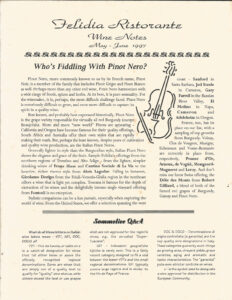 Felidia Ristorante
Felidia Ristorante
Wine Notes
May – June 1997
Who’s Fiddling With Pinot Nero?
Pinot Nero, more commonly known to us by its French name, Pinot Noir, is a member of the family that includes Pinot Grigio and Pinot Bianco as well. Perhaps more than any other red wine, Pinot Nero harmonizes with a wide range of foods, spices and herbs. At ist best, it is pure sensuality. For the winemaker, it is, perhaps, the most difficult challenge faced. Pinot Nero is notoriously difficult to grow, and even more difficult to capture its spirit in a quality wine.
Best known, and probably best expressed historically, Pinot Nero is the grape variety responsible for virtually all red Burgundy (except Beaujolais). More and more “new world” Pinots are appearing – California and Oregon have become famous for their quality offerings, South Africa and Australia offer their own styles that are rapidly making their mark. But, perhaps the least known, despite years of cultivation and quality wine production, are the Italian Pinot Neros.
Generally lighter in style than the Burgundian style, Italian Pinot Nero shows the elegance and grace of the fruit. Sample Felidia’s offerings from the norther regions of Trentino and Alto Adige – from the lighter, simpler drinking wines of Franz Haas and Cantina Sociale di La Vis to the heartier, richer riserva style from Alois Lageder. Falling in between, Girolamo Dorigo from the Friuli-Venezia-Giulia region in the northeast offers a wine that is light yet complex. Toscana is famous for the depth of extraction of its wines and the delightfully intense single vineyard offering from Fontodi is no exception.
Stylistic comparisons can be a fun pursuit, especially when exploring the world of wine. From the United States, we offer a selection spanning the west coast – Sanford in Santa Barbara, Jed Steele in Carneros, Gary Farrell in the Russian River Valley, El Molino in Napa, Cameron and Adlesheim in Oregon.
France, too, has its place on our list, with a sampling of top growths from Burgundy. Volnay, Clos de Vougeot, Musigny, Echezeaux and Vosne-Romanée are currently in place from, respectively, Pousse d’Or, Arnoux, de Vogüé, Mongeard-Mugneret and Leroy. And don’t miss our latest Swiss offering, the Dôle des Monts from Robert Gilliard, a blend of both of the famed red grapes of Burgundy, Gamay and Pinot Nero.
Sommelier Q&A
What do all those letters on Italian wine labels mean – VDT, IGT, DOC, DOCG, e?
VDT – Vino da tavola, or table wine is a catch-all designation for wines that fall either below or above the officially recognized regional denominations. Some are wines that are simply not of a quality level to qualify for “quality” wine status, while others exceed the level or use grapes which are not approved for the region’s wines, e.g., the so-called “Super-Tuscans”.
IGT – Indicazioni geografiche tipiche is rarely seen. This is a fairly recent category designed to fill a void between the lesser VDTs and the small regional denominations. IGT typically covers large regions and is similar to the Vin de Pays of France.
DOC & DOCG – Denominazione di origine controllata (e garantia) are the top quality wine designations in Italy. These categories guarantee such things as growing area, vineyard yields, grape varieties, aging, and aromatic and taste characteristics. The “garantia” puts even stricter controls on wines.
e – is the symbol used to designate a wine approved for distribution in the European Community.